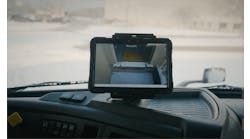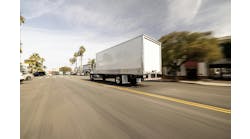Corrosion is a cancer.
It arrives uninvited and if left unchecked destroys the structural metals used in everything from trailers, truck bodies and transmissions, to bridges and pipelines, potentially leading to catastrophic results.
Fortunately, AZZ Metal Coatings has an answer, or two – powder coating and hot-dip galvanizing.
The company’s Jim Hutchison, an area sales and marketing manager, and Bernardo Duran, a coating performance engineer, discussed the two methods of metal protection, and the benefits of joining the systems, at the National Association of Truck Manufacturers show.
“These are systems that can be complimentary as well as competitive, so we thought … we needed to widen our stance to offer potential customers everything they could want in these areas,” Hutchison said.
Paint of a different color
Powder coating protects against corrosion by forming a barrier between a base metal and the atmosphere. The coating is like a paint but, because it’s in a dry form, it’s applied differently, using an electrostatic method of charging the coated item, and then cured to bond the powder to the metal.
Hutchison said the process is relatively simple but far from easy to execute.
“One of the disadvantages to the powder-coating system, for one who’s an applicator, for our company, is that it’s very low-barrier to enter,” he said. “So folks can get into this business and not really know what they’re doing. So properly applying powder coating is crucial for the effectiveness of the system.”
When done properly, powder coating is more precise and durable than spray painting.
“This is just paint, but it’s really good paint, and it’s controlled in the thickness, so the advantage of powder coating vs. wet paint is controlled and consistent thickness,” Hutchison said.
Powder coating provides advantages for manufacturers, too.
It’s an outsourced process, so when it is applied correctly – by a reputable applicator – it’s worry-free and eliminates air quality issues at the plant, it’s non-flammable, so it’s safe, and it’s environmentally friendly because overspray is retrieved and recycled, leaving no waste or ground-water issues.
“It’s a really nice process for the environment as well as your manufacturing operations,” Hutchison said.
The coating process also offers appearance and performance advantages.
Powder-coated metal stays bright and vibrant longer, and the metal is uniformly covered, with no wet paint running or dripping, and the powder coating itself is highly resistant to scratching and denting.
It is not, however, impenetrable.
And if the barrier coating somehow is broken, the underlying metal will corrode, forming pockets of rust that swell and lift the powder coating from the surface in an ugly blister that will continue to grow.
“This is a very good system, but it is a barrier system and it has its limitations,” Hutchison said.
Extra strength through zinc
Corrosion is an electrochemical reaction that’s destructive – and costly.
According to a NACE IMPACT report published in 2016, the global cost of corrosion is estimated at $2.5 trillion annually, or 3.4 percent of the global GDP. In 2013, corrosion cost the United States $451 billion.
So it makes sense – and save cents – to go the extra mile to prevent corrosion from occurring.
Hot-dip galvanizing is a good way to get there.
Galvanizing, essentially, is the process of putting zinc on metal.
The goal is to create a “galvanic cell” that offers cathodic protection for the metal substrate, or cathodic metal, which is electropositive, by sacrificing the zinc, or anodic metal, which is electro negative.
“If you have two metals that are dissimilar in an electrolyte, the higher end … would be the anode, and it would corrode,” Duran said. “So, for example, if you have zinc and steel connected, zinc is higher on the chart, so it would be the anode and it would corrode, and the steel would be the cathode.
“That would be the protected metal.”
The galvanizing process includes chemically cleaning the metal, rinsing it, pickling in a sulfuric-acid solution, purifying in a flux solution of zinc ammonium chloride, and then submerging the metal in a 98-percent pure zinc bath that’s heated to at least 830 degrees Fahrenheit – thus the hot dip.
With this type of sacrificial zinc cathodic protection, even damaged areas of the coating will be cathodically protected by the surrounding zinc.
Hot dip galvanizing also provides complete coverage, through the emersion process, uniform protection across every surface, a maintenance-free zinc patina, abrasion resistance – because the zinc is metallurgically bonded to the steel – and sustainability, since steel and zinc are recyclable.
Galvan estimated a zinc coating with a thickness of 3.0 mils provides 50 years of protection in an industrial setting.
“The galvanized coating is the same on flat areas as it is on corners and edges,” Duran said. “That’s a very important property. For wet paint, the wetness of the paint pulls away that paint coating from those edges, which means the edges are more likely to corrode faster.”
Combining anti-corrosive forces
Corrosion is a formidable enemy, with the potential to inflict massive damage to people, property and businesses, and cost billions of dollars in repair and replacement.
AZZ recommends combating corrosion with powder coating, hot-dip galvanizing – or both.
“We can also powder coat galvanized steel,” Hutchison said. “One of the misconceptions about powder coating is that it doesn’t work on galvanized steel. Nothing could be further from the truth.”
The combination is appealing.
If a battleship-gray zinc coating isn’t desirable, amp it up aesthetically with a powder coating in any color imaginable.
And the resulting marriage is 1.5 to 2.3 times stronger than galvanizing alone.
“The reason for that is the barrier system delays the beginning of that oxidation process of the zinc, so that migration from zinc hydroxide to zinc carbon is delayed by that barrier,” Hutchison said.
“It’s amazing how much time this adds to the surface life of your products. So if you’ve got a severe-duty trailer and you want some aesthetics, don’t shy away from powder coating, but think about it as a top over galvanizing.”











